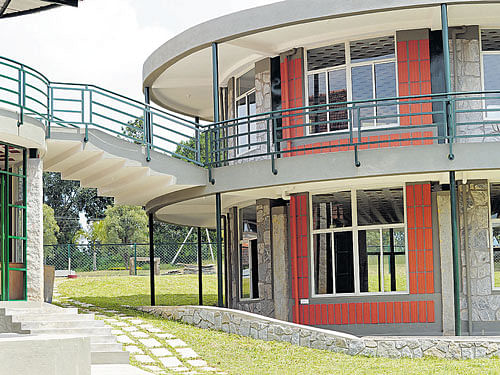
Playing around the sustainable designs has been the signature style of Krishnarao Jaisim, the founder of Jaisim Fountainhead, a well-known architecture firm in Bengaluru. His projects predominantly include eco-friendly elements that not only sustain for a longer period, but also enhance the aesthetic appeal of the structure.
Right from his first project ‘Ego’, a residential project in Chennai (1970), Krishnarao has made sure to consider all the sustainability factors, though the ‘eco-friendly’ concept was still at its nascent stage during the ‘70s. Having finished a Bachelor’s of Architecture from Madras University, Krishnarao has come a long way endeavouring to give innovative
designs that satisfy not just his clients, but also himself. He is one of the few
architects who has tried his hand in almost all sectors of architecture.
He has been the past chairman of Indian Institute of Architects (IIA), Karnataka chapter. Today at the age of 72, he still continues to pursue the adventures of the built environment, searching and researching beyond the boundaries of time and space. Krishnarao speaks to Deccan Herald about his 50 years of adventurous journey in the architectural arena, concept of sustainability and future of architecture. Excerpts:
Having spent more than five decades in architecture, how do you recall your journey?
It was an adventurous journey into the multi-faceted dimension of the built and the unbuilt environment — painfully joyful. Very often, it is a lonely journey, if you are pursuing your ideologies and philosophy. There were instances where clients lost faith in architects. Failure is not an architectural word. But, one should not forget that every failure is the stepping stone for success. And, it will be a learning experience.
What was the principal philosophy on which your organisation was founded?
The novel that I got as a gift from my brother Ramchand, Ayn Rand’s The Fountainhead changed my life. I lived each and every word of it. So, the first inspiration I drew was from the author which gave birth to my own firm The Fountainhead in 1970. Other prominent characters who have had a great impact on my life are great architects Otto Königsberger, Geoffrey Bawa and Buckminster Fuller.
You have successfully completed projects in all sectors. Which one has been challenging for you?
Residential individual homes on various terrains in different climatic zones, and cultural and personal identities are the most that has been challenging.
Sustainable designs have been a main element in your projects. Please elaborate on this concept.
In all my projects, I endeavour to include eco-friendly concepts and give more importance to the use of natural resources such as light and greenery around the space. One should make maximum utilisation of space and should make sure it meets the clients’ taste and requirement. One should be simple in their forms. Honesty to space and material is a basic element for any project. I believe in recycling the materials. Architecture should embrace and surpass context and content. A sense of abstract spiritualism defines the design and memories are born to be cherished which I do convey through my projects. My endeavour from the past 50 years has been to deliver the end product that meets the sustainable elements.
Future trends in architecture...
I feel that architecture will witness a phenomenal phase in the coming years. Three or four decades from now, it will give way to exploring new lifestyles. Today’s clients are not the same. Technology is not the same. Few comprehend ‘art’ for really what it is. The new stars of today are films, sports and mania-driven. Entertainment is the ‘future of human lifestyle’.
On the other hand, urbanisation is very important; you cannot stop city growing to a next level. There is a bright future in the built spaces, dense urbanisation with vertical high-rise and the open sprawl of the rural habitat gives opportunity for landscaping. The limits to innovative imagination will be stretched beyond the realm pushing the integration of art and technology to new heights of creativity.
You draw inspiration from...
The Fountainhead, from my family, my students, my peers, the media which challenges on different levels, the people, sheer technology, the arts - the many dimension that challenge every line and sketch.
Your advice to young architects?
They should believe in oneself. Strengthen conviction with courage, learn to learn, patience to unlearn. Take time and space, the many aspects of human life — wander awaken your senses, study the elements and realise the reality.
What drives you to be so enthusiastic even today?
New paths, without compromises give me strength to go ahead with my new ventures. There are ups and downs in everyone’s life but a little meditation awakens the mind and soul and, pushes the body to seek, learn and achieve.
Your upcoming projects...
There are a few projects that I am doing in the villages — beyond the urbanfold. Rural population is more comprehending and respectful and has that sense of magic that drives my imagination and innovation. They are the future of great architectural realisations. Farmhouses, weekend retreats, are a new dimension.
Currently, we are working on a project for Art of Living. The proposed project is a mass congregational spiritual space. It is beyond form and function as it transcends to an experiential plane integrating with the context. Another interesting project is a farmhouse in Malavalli. It is an organic abode with only nature setting its limits. Wisdom pervades the spaces of the Malavalli home. A school on Kanakapura Road — A ‘Shaale’ to the children is another project that is close to our hearts, with freedom as the fundamental discipline of learning, reflected in its spaces and concept.